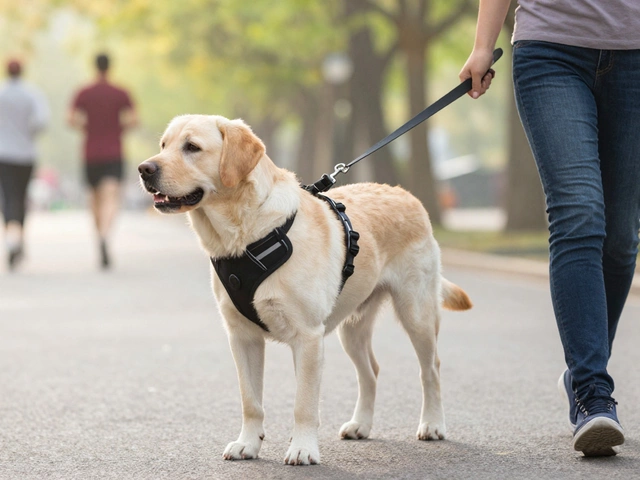
Ever noticed how some people just snap a leash to their dog’s collar and stroll out the door like it’s no big deal? It seems simple, right? But there’s a whole world of debate around whether it’s actually safe—or even kind—to walk your dog using only a collar. If you’ve ever been yanked down the street by an overexcited pup, or caught that gasp-for-air sound when a leash goes taut, you’ve probably wondered if there’s a better way. So let’s cut through the noise and get real about walking your dog with just a collar.
The Real Risks and Truths of Walking With Just a Collar
People have been using collars to walk their dogs for centuries. It’s quick, cheap, and every pet store walls are lined with colorful choices. But times have changed, and so has what we know about animal health and behavior. Modern studies show that walking a dog with only a collar can have more drawbacks than most folks realize, especially as most dogs aren’t exactly masters of polite leash walking (I’m looking at you, Luna, my golden retriever with two settings: couch potato and racehorse).
First, let’s talk about the physical dangers. When a dog pulls, the force gets concentrated on the neck. For small breeds, this can mean collapsing tracheas (think tiny windpipes that get crushed), while larger dogs risk damage to their thyroid glands, neck vertebrae, and even eyes—yep, a sudden jerk can increase eye pressure enough to worsen conditions like glaucoma. According to a 2023 study in the Journal of Veterinary Behavior, dogs regularly walked on collars were three times more likely to develop neck injuries compared to those walked on harnesses. And it’s not just the occasional strong tug. Over time, the repetitive stress can cause chronic pain, cough, or even abnormal behavior due to discomfort.
There’s also the escape problem. Slipping out of a collar is practically a party trick for some pups, especially those with slender heads or thick necks, like greyhounds or huskies. I once watched a neighbor’s whippet manage a Houdini move right in front of oncoming traffic. Let’s just say my heart did not appreciate the excitement.
Behavioral fallout is often overlooked. Dogs that feel pain or restriction on their necks can develop negative associations with walks or certain environments. Ever see a dog duck from their collar or freeze on leash? That’s their way of saying, “No thanks.” Plus, if your dog lunges at squirrels, skateboarders, or just because they’re having a moment, all that pressure lands straight on their throat. Not exactly a recipe for good behavior or trust.
Then there’s the legal angle. Some cities or counties require that dogs be walked on secure equipment. In places like San Francisco and Toronto, animal control officers have started cracking down on off-the-cuff setups after a spike in lost pets and bite incidents. Insurance companies are also getting pickier—some will deny claims if your dog escapes or injures someone while walking on an inappropriate leash setup.
Here’s a quick comparison to dig into the studies and data—
| Method | Risk of Escape | Neck Injury Risk | Control for Handler | Veterinarian Recommendation (%) |
|---|---|---|---|---|
| Flat Collar Only | High | Moderate-High | Low-Moderate | 18% |
| Martingale Collar | Low-Moderate | Moderate | Moderate | 29% |
| Front-Clip Harness | Low | Very Low | High | 71% |
| Back-Clip Harness | Low | Low | Moderate | 45% |
That ‘Veterinarian Recommendation’ column tells a story. Nearly three-quarters of surveyed vets said they prefer harnesses, especially for young, large, or excitable dogs. Traditional collars came in dead last.

Collars, Harnesses, and Hybrid Options: What Gear Actually Works?
Not all collars are created equal. There’s the flat collar: your classic buckle or snap—great for holding ID tags, not so great for wrangling a pulling beast. Then there are martingale collars, designed for narrow-headed breeds, with a limited-slip function to reduce the risk of escape and choking. But even these aren’t meant for all-day use or regular walking.
Harnesses, on the other hand, spread force across a dog’s chest and shoulders—the bulkier, more muscular areas. This simple change does wonders for both control and comfort, especially for breeds with fragile necks or spines. Doctors at Tufts University did a seven-month trial in 2022 with nearly 100 shelter dogs; when they switched from collars to well-fitted front-clip harnesses, they saw a 60% drop in leash-pulling, and stress behaviors like panting and pacing cut in half.
Front-clip harnesses are especially great if you’ve got a four-legged sled dog at home. These shift the pulling force sideways, which gently steers your dog back toward you rather than letting them hit full throttle. Back-clip harnesses are comfier for calm dogs, but don’t stop pulling as effectively. Some people mix setups: a collar for ID, a front-clip harness for walks, and a double-ended leash for extra security.
What about old-school gear like choke chains or prong collars? Most modern trainers and vets urge regular folks to avoid them. In a 2022 poll by the British Veterinary Association, only 7% of vets recommended their use, and that was mostly for specific training under supervision. These tools can inflict serious injury if used improperly, and often damage trust and confidence between you and your dog.
Here’s a cheat sheet on selecting the right walking gear for your pup:
- Big, powerful pullers: Try a well-padded front-clip harness.
- Shy, fearful rescues: Look for no-escape harnesses with extra chest straps.
- Tiny breeds with fragile necks: Step-in or Y-front harnesses are safest.
- Greyhounds, whippets: Consider martingale collars only if you must, but pair with a harness for walks.
- Old or arthritic dogs: Light, padded harnesses prevent neck strain.
- Puppies: Harnesses teach better habits from day one.
- ID tags: Attach to your dog’s collar, regardless of main walking gear.
Check the fit before each walk. You should be able to slip two fingers under any strap, and nothing should ride up toward the throat or cause rubbing. Don’t leave harnesses on unsupervised—dogs have gotten snagged during play or in crates. And if your dog hates new gear? Try incremental desensitization—let them wear the harness or collar indoors with plenty of treats until it’s no big deal.

Practical Tips to Keep Your Dog Safe and Happy On Walks
Let’s cut right to it: if you want your walks to be safe for both you and your dog, there’s no room for shortcuts. If you still feel tempted to use just a collar, consider these real-world factors that sometimes get missed when people focus only on convenience.
First off, leash skills matter just as much as the gear. Most dogs don’t come factory-installed with heel or calm walking behaviors. One Massachusetts animal shelter tracked their intake dogs in 2024 and found 58% had never been taught loose-leash walking, and almost three-quarters of return adoptions related to leash and walking problems! Training your dog, even five minutes a day, pays off huge—start indoors, reward calm walking, and work your way up to busier areas. If your dog gets distracted or anxious on walks, try high-value treats, a calm voice, and patience over pulling or corrections.
If you live in busy neighborhoods, close to traffic, or anywhere with wildlife or stray dogs, an extra-secure walking setup isn’t just a luxury, it’s a necessity. A sturdy harness or a backup clip to the collar and harness means if one breaks, your dog won’t make a break for it. Some dog lovers add LED collars or reflective harnesses on nightly strolls—hospital stats show most pet-car collisions happen during twilight hours.
Weather matters too. Hot pavement can burn paws, while ice can cause slips. If your dog pulls suddenly on slick surfaces, a collar ramps up injury risk; a harness gives better support and control if things get wild. And let’s talk about those leash laws—almost every city requires your dog to be “under control”; if your dog slips a collar or drags you into traffic, you could be facing more than just shame from your neighbors.
You know your dog best. Some mellow, well-trained older dogs are fine with flat collars, short strolls, and never a hint of pulling. But for everyone else? Harnesses win every time. The comfort, safety, and control just make life easier for humans and pups alike.
If you want your dog to actually enjoy walks—and come home without injury or escape drama—think about investing in the right setup. Because when you take your dog out, it’s not just about getting from point A to B. It’s about trust, comfort, and keeping your best friend out of harm’s way.





